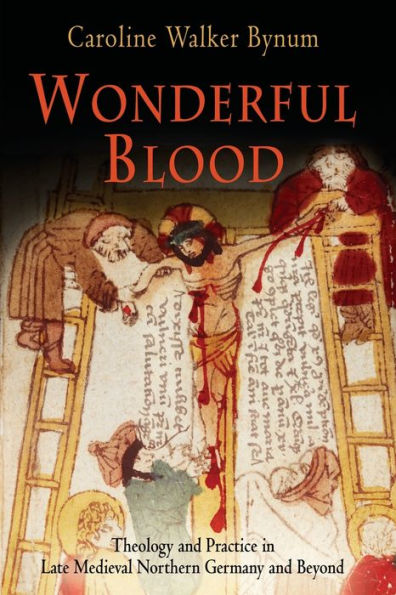5
1

Wonderful Blood: Theology and Practice in Late Medieval Northern Germany and Beyond
456
by Caroline Walker Bynum
Caroline Walker Bynum

Wonderful Blood: Theology and Practice in Late Medieval Northern Germany and Beyond
456
by Caroline Walker Bynum
Caroline Walker Bynum
Paperback
$39.95
-
PICK UP IN STORECheck Availability at Nearby Stores
Available within 2 business hours
Related collections and offers
39.95
In Stock
Overview
The quiet market town of Wilsnack in northeastern Germany is unfamiliar to most English-speakers and even to many modern Germans. Yet in the fifteenth century it was a European pilgrimage site surpassed in importance only by Rome and Santiago de Compostela. The goal of pilgrimage was three miraculous hosts, supposedly discovered in the charred remains of the village church several days after it had been torched by a marauding knight in August 1383. Although the church had been burned and the spot soaked with rain, the hosts were found intact and dry, with a drop of Christ's blood at the center of each.
In Wonderful Blood, Caroline Walker Bynum studies the saving power attributed to Christ's blood at north German cult sites such as Wilsnack, the theological controversy such sites generated, and the hundreds of devotional paintings, poems, and prayers dedicated to Christ's wounds, scourging, and bloody crucifixion. She argues that Christ's blood as both object and symbol was central to late medieval art, literature, pious practice, and theology. As object of veneration, blood provided a focus of intense debate about the nature of matter, body, and God and an occasion for Jewish persecution; as motif, blood became a prominent subject of northern art and a central symbol in the visions of mystics and the prayers of ordinary people.
In Wonderful Blood, Caroline Walker Bynum studies the saving power attributed to Christ's blood at north German cult sites such as Wilsnack, the theological controversy such sites generated, and the hundreds of devotional paintings, poems, and prayers dedicated to Christ's wounds, scourging, and bloody crucifixion. She argues that Christ's blood as both object and symbol was central to late medieval art, literature, pious practice, and theology. As object of veneration, blood provided a focus of intense debate about the nature of matter, body, and God and an occasion for Jewish persecution; as motif, blood became a prominent subject of northern art and a central symbol in the visions of mystics and the prayers of ordinary people.

Product Details
| ISBN-13: | 9780812220193 |
|---|---|
| Publisher: | University of Pennsylvania Press, Inc. |
| Publication date: | 11/05/2007 |
| Series: | The Middle Ages Series |
| Pages: | 456 |
| Product dimensions: | 6.12(w) x 9.25(h) x 1.10(d) |
About the Author
Caroline Walker Bynum is Professor of Medieval History at the Institute for Advanced Study in Princeton, New Jersey. Past president of both the American Historical Association and the Medieval Academy of America, she was a MacArthur Fellow from 1986 to 1991. She is the author of numerous books, including Metamorphosis and Identity, The Resurrection of the Body in Western Christianity, 200-1336, Fragmentation and Redemption: Essays on Gender and the Human Body in Medieval Religion, and Holy Feast and Holy Fast: The Religious Significance of Food to Medieval Women, and is the editor, with Paul Freedman, of Last Things: Eschatology and Apocalypse in the Middle Ages, also published by the University of Pennsylvania Press.
Table of Contents
List of IllustrationsPreface
Some Notes on Usage
Chapter 1. Introduction: A Frenzy for Blood
—The Emergence of Blood Piety
—Blood in the Fifteenth-Century North
—Some Recent Approaches
PART I. CULTS IN NORTHERN GERMANY
Chapter 2. Wilsnack
—The Events
—Historiography
—Blood at the Center
—Treatises de Sanguine
—Larger Questions
Chapter 3. Cults in Mecklenburg and the Mark Brandenburg
—Historiography and the Problem of the Evidence
—Blood Cult in Middle Germany and the Havelland
—North and West of Wilsnack
—Anti-Jewish Libels Circa 1500: Sternberg and Berlin
—The Fate of Cults in the Sixteenth-Century North
—Holy Matter and the Jews
PART II. BLOOD DISPUTES IN FIFTEENTH-CENTURY EUROPE AND THEIR BACKGROUND
Chapter 4. Debates About Eucharistic Transformations and Blood Relics
—Visions and Transformations
—The Practical Issue of Transformed Hosts
—Concomitance and the Cup
—The Debate over Blood Relics: Background
—Grosseteste, Bonaventure, and Aquinas on Blood Relics and Identity
—Gerhard of Cologne
—Discussions of Blood Relics in the Fifteenth Century
Chapter 5. Christ's Blood in the Triduum Mortis
—Mayronis and the Barcelona Controversy of 1350-51
—John of Capistrano on the Precious Blood
—The Triduum Mortis Debate of 1462-64
—Some Arguments Attributed to Nicholas of Cusa
—Patterns in Dominican and Franciscan Theology
—Conclusion
PART III. THE ASSUMPTIONS OF BLOOD PIETY
Chapter 6. A Concern for Immutability
—The Immutability Theme at Wilsnack
—The Transformed-Hosts Debate: A Deeper Issue
—Immutability in Debates over Blood Relics and Treatises de Sanguine
—Wholeness and Immutability in Story and Cult
—Devotional Images
—Conclusion
Chapter 7. Living Blood Poured Out
—Blood as Fertility
—Blood as Social Survival
—Blood as Engendering and Gendered
—Blood as Sedes Animae
—Continuity in Discontinuity: The Exsanguination of Christ
—Blood as Alive
Chapter 8. Blood as Separated and Shed
—The Stress on Separation
—Blood as Drops
—The Revelation of the Hundred Pater Nosters
—Accusation and Reproach
—Blood as Symbol
—The Deeper Paradox: Sacrifice
PART IV. SACRIFICE AND SOTERIOLOGY
Chapter 9. Late Medieval Soteriology
—Salvation as Satisfaction and Response: The Conventional Account
—Salvation as Participation
—Julian of Norwich
—Conclusion
Chapter 10. Sacrificial Theology
—The Biblical and Patristic Background
—Destruction and Oblation
—Sacrifice in Blood Cult and Controversy
—The Sixteenth Century
Chapter 11. The Aporia of Sacrifice
—Questioning Blood: The Meditations on the Life of Christ
—Avoiding Sacrifice
—Who Sacrifices? Including/Excluding Christians and Blaming Jews
—Sacrifice and the Marking of Matter
Chapter 12. Conclusion: Why Blood?
List of Abbreviations
Notes
Bibliography of Works Cited
Index
Acknowledgments
From the B&N Reads Blog
Page 1 of
